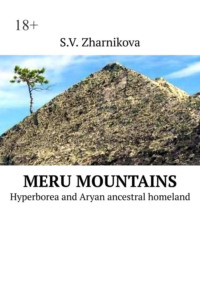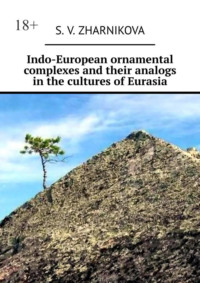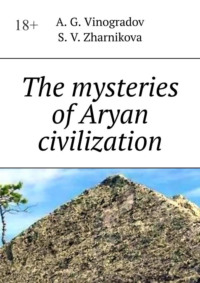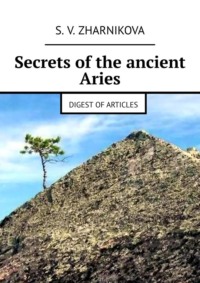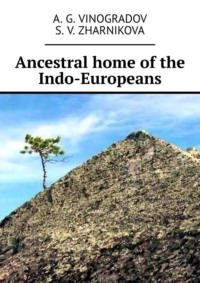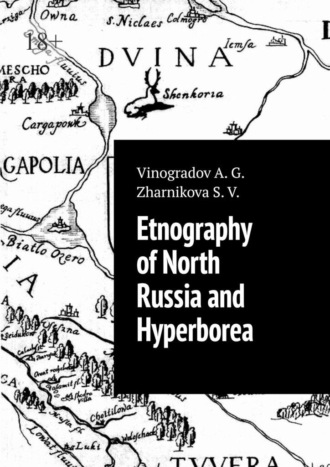
Полная версия
Etnography of North Russia and Hyperborea

Etnography of North Russia and Hyperborea
A. G. Vinogradov
S. V. Zharnikova
Editor Алексей Германович Виноградов
Illustrator Алексей Германович Виноградов
Translator Алексей Германович Виноградов
© A. G. Vinogradov, 2025
© S. V. Zharnikova, 2025
© Алексей Германович Виноградов, illustrations, 2025
© Алексей Германович Виноградов, translation, 2025
ISBN 978-5-0065-5450-4
Created with Ridero smart publishing system
Problems of localization of the ancestral home of the Indo-Europeans
The problem of localization of the ancestral homeland of Indo-European peoples has been facing science for a long time. As far back as the mid-18th century, the linguistic kinship of European peoples was noted, and in 1767, Kerdu pointed out the proximity of a number of European languages to Sanskrit, the language of the sacred texts of Ancient India «Vedas. «The decisive for the emergence of Indo-European studies was the discovery of Sanskrit, acquaintance with the first texts on it and the enthusiasm that began with ancient Indian culture, the most striking reflection of which was the book of F. von Schlegel» On the language and wisdom of Indians ” (1808), writes V. N. Toporov. F. von Schlegel, the first to express the idea of a single ancestral home of all Indo-Europeans, placed this ancestral home on the territory of Hindustan. However, the fallacy of this assumption was soon proved, since before the arrival of the Aryan (Indo-European) tribes, India was inhabited by representatives of another language family and another one-time type – black Dravids.
Assumed at different times as the ancestral home of the Indo-Europeans (today this is the people of 10 language groups: Indian, Iranian, Slavic, Baltic, German, Celtic, Romance, Albanian, Armenian and modern Greek): India, the slopes of the Himalayas, Central Asia, Asian steppes, Mesopotamia, Near and Middle East, Armenian Highlands, territories from Western France to the Urals between 60° and 45° N, territory from the Rhine to the Don, Black Sea-Caspian steppes, steppes from the Rhine to Hindu Kush, areas between the Mediterranean and Altai, in Western Europe – currently, for one reason or another, most researchers rejected.
It should be noted that the Soviet historical school until the beginning of the 30s of the 20th century proceeded from the definition of the ancestral home of the Indo-Europeans based on the works of A. A. Shakhmatov and L. I. Niederle. The ancestral home of the Indo-Europeans, based on naturally geographical factors, was placed by them in Moravia and Silesia. At the same time, the ancestral home of the East Indo-Europeans (Slavs, Albanians, summer-Lithuanians, Armenians, Indo-Iranians) was placed in the Moscow and Tver regions, in the upper Dnieper.
The ancestral home was placed by the Baltov in the Minsk and Vitebsk regions.
The ancestral home of the Slavs was located by them from Prussia to Pskov, along the banks of the Neman, Dvina and the Gulf of Riga. It was assumed that later the East Indo-Europeans moved south along the Dnieper, to the Black Sea, where the Aryans formed – the Indo-Iranians, who then left the Don to Iran and India. Slavs moved to Poland and further to the Balkans, Carpathians and Ukraine.
Similar scientific hypotheses were then replicated, in particular, in K. Kudryashov’s mass-circulation «Russian Historical Atlas» issued by the State Publishing House in 1928. Despite fundamentally different scientific views, this work was supported and approved by academicians M. N. Pokrovsky, S. F. Platonov, S. V. Voznesensky, B. D. Grekov, N. S. Derzhavin, Yu. G. Oksman, P F. Preobrazhensky, A. E. Presnyakov, O. N. Serbina, A. V. Shebalov.
But then, in 1929, «Russian history» itself was recognized as counter-revolutionary, and in 1932—36 the theory of the ancestral home was declared by communist ideologists – not Bolshevik, fascist and anti-scientific.
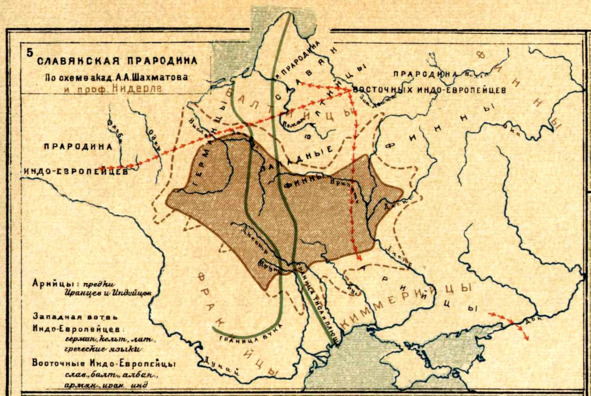
Russian historical atlas of K. Kudryashov
Among the hypotheses formulated in recent years, I would like to dwell on two in more detail: V. A. Safronov, who proposed in his monograph Indo-European Ancestral Homes the concept of the three ancestral homelands of Indo-Europeans —
in Asia Minor, the Balkans and Central Europe (Western Slovakia), and T.V. Gamkrelidze and V.V. Ivanov, who own the idea of the Near-Asian (more precisely, located on the territory of the Armenian Highlands and adjacent areas of Western Asia) the ancestral home of the Indo-Europeans, spelled out and argued by them in the fundamental two-volume «Indo-European language and Indo-Europeans».
V. A. Safronov, referring to the work of N. D. Andreev, emphasizes that on the basis of the Early Indo-European (hereinafter RIE) vocabulary, we can conclude that «early Indo-European society lived in cold places, may be in the foothills, in which there were no large rivers, but rivulets, streams, springs; rivers, despite the rapid flow, were not an obstacle; crossed through them in boats. In winter, these rivers froze, and in spring they spilled scattered and swamps… The climate of the RIE ancestral homeland was probably sharply continental with severe and cold winters, when the rivers froze, strong winds blew; «in a stormy spring with thunderstorms, heavy snowmelt, river spills, hot dry summers when the grass was drying out, there was not enough water.» The early Indo-Europeans had early phases of agriculture and cattle breeding, although hunting, gathering and fishing did not lose their significance. Among the tamed animals are a bull, a cow, a sheep, a goat, a pig, a horse and a dog that guarded the herds. V. A. Safronov notes that: «Riding was practiced by the early Indo-Europeans: what animals were circled around is not clear, but the goals are obvious: taming.» Agriculture was represented by a hoe and fire-arm form, processing of agricultural products was carried out by grinding grain. The early Indo-European tribes lived settled; they had different types of stone and flint tools, knives, shelters, scrapers, axes, adzes, etc. They exchanged and traded. In the early Indo-European community, there was a difference in childbirth, taking into account the degree of kinship, and juxtaposition of friends and foes. The role of women was very high. Particular attention was paid to the «progeny generation process», which was expressed in a number of root words that passed into the Early Indo-European language from the boreal parent language.
In early Indo-European society, a paired family stood out, management was carried out by the leaders, and there was a defensive organization. There was a cult of fertility associated with zoomorphic cults, was a developed funeral rite. From the foregoing, V. A. Safronov concludes that the ancestral home of the early Indo-Europeans was in Asia Minor. He notes that such an assumption is the only possible, because: «Central Europe, including the Carpathian basin, was occupied by a glacier».
However, the data of paleoclimatology indicate something else. At the time in question, those during the final stage of the Valdai glaciation (the chronological framework of which is established from 11,000 to 10,500 years ago), the nature of the vegetation cover of Europe, although it was different from the modern one, but in Central Europe, arctic tundra with birch-spruce woodlands, low-mountain tundra and alpine meadows were common, not a glacier. Sparse forests with birch-pine stands occupied most of Central Europe, and steppe vegetation prevailed on the Great Central Danube Lowland and in the southern part of the Russian Plain.
Paleogeographers note that in the south of Europe the influence of the ice sheet was not felt, especially in the Balkans and Asia Minor, where the influence of the glacier was not felt at all. The time, to which the culture of Asia Minor Chatal Gayuk belongs, associated by V.A. Safonov with the early Indo-Europeans, marked by the warming of the Holocene.
As early as 9780 years ago, elms appear in the Yaroslavl Region, 9400 years ago in the Tver Region of lindens, 7790 years ago in the Leningrad Region, oaks.
The more unlikely the presence of a cold climate in Asia Minor. Here I would like to refer to the conclusions of L. S. Berg and G. N. Lisitsina, made at different times, but, nevertheless, not refuting each other. So L.S. Berg in his work «Climate and Life» (1947) emphasized that the climate of the Sinai Peninsula has not changed over the past 7 thousand years and that here and in Egypt, «if there was a change, it would rather increase, and not a decrease in precipitation».
He noted that: «Blankenhorn believed that in Egypt, Syria and Palestine the climate remained broadly constant and similar to that present since the end of the pluvial period; the end of the latter, Blankenhorn attributes to the beginning of the interglacial epoch» (130—70 thousand BC).
In his 1921 work, Blankenhorn writes that «From the Riess-Wurm interglacial (mousterien of Western Europe) to the present (in these territories) a dry desert climate, and in the north a semi-arid climate, similar to the modern one, interrupted by a short wet time corresponding to the Wurm glaciation.» G. N. Lisitsina comes to similar conclusions, who write in 1970: «The climate of the arid zone in the XVII millennia BC not much different from the modern one». We have no reason to believe that the climate of the west of Asia Minor, where daphne, cherry, barberry, maquis, Calabrian pine, oak, hornbeam, hop hornbeam, ash, white and prickly astragalus also live, also live animals like mongoose, jackal, porcupine, mouflon, wild ass, hyena, bats and locusts, and «snow does not fall every year, snow cover, as a rule, does not form», in 8—7 thousand BC so significantly different from the modern that it could be similar to that harsh ancestral home of the early Indo-Europeans, which is reconstructed on the basis of their vocabulary.
In addition, V. A. Safonov writes: «The close relationship between the boreal and the Turkic and Uralic languages, according to N. D Andreyev, allows localization of the boreal community in the forest zone from the Rhine to Altai.
From this it also follows that from all areas where RIE carriers could have gone, Anatolia seems to be the only possible one: narrow straits did not serve as an obstacle, since the early Indo-Europeans knew the means of crossing (the «boat» was recorded in the language of the early Indo-Europeans).»
Recall that according to the conclusions of N. D. Andreev: «Of the landscape vocabulary in the boreal proto-language, root words are most abundantly represented, one way or another connected with the forest. The image of this row clearly indicates, firstly, the wooded nature of the area where the tribes who spoke BP lived, and secondly, the presence of conifers in these forests.» But a strip of coniferous forests at 10—9 thousand BC stretched not from the Rhine to Altai (in a latitudinal direction, as N. D. Andreev suggests and after him V. A. Safronov), but submeredionally from the southwest (from the foothills of the Carpathians) to the northeast (to Pechora). Consequently, the early Indo-Europeans from this forest zone could begin their progress in all directions (including to the territory of Asia Minor), from which, naturally, it does not follow that the population of Chatal Guyuk at the end of the 8th-beginning of the 7th millennium BC as not Indo-European. It is likely that Chatal Guyuk was only a small part of the vast early Indo-European range. Recall that this time (7 thousand BC) was the time of the peak of mixed deciduous forests, reaching in the north of Eastern Europe to the coast of the White Sea, and that the early Indo-Europeans for livestock-farming (slash-and-burn agriculture) in complex with hunting, fishing and gathering required very large territories.
And although V. A. Safronov writes that: «At the beginning of the Mesolithic, the zone of the producing economy was extremely limited» and included «only the mountains of Zagros, Southeast Anatolia, Northern Syria, and also Palestine», the presence of a producing economy on the territory Eastern Europe in 7 thousand BC, as noted earlier, is evidenced by archaeological materials obtained in recent years. Again referring to the conclusions of G. N. Matyushin, we emphasize that on the border of 7—6 thousand BC in the Southern Urals, the presence of a domestic horse is recorded and the remains of domestic animals (goats, sheep, cattle, horses and dogs) have been found at 22 sites. Recall that this particular set of domesticated animals – bull, cow, sheep, goat, pig, horse and dog – was recorded in the vocabulary of the early Indo-Europeans. And, of course, the deep kinship, the ancestor of the early Indo-European proto-language – the ancient boreal (northern) language with the Uralic (Finno-Ugric) and Altai (Turkic) languages naturally follows from the localization of the tribes of the speakers of this boreal language in the era of the final of the Upper Paleolithic (15—10 thousand BC) precisely in the zone of mixed and coniferous forests, i.e. in Eastern Europe. The migrations of a part of the boreal tribes beyond the Urals, to the territory of Siberia and to the foothills of Altai are logical and explainable by the pressure of the population surplus in the territory of Eastern Europe during this period, which could be caused by the lack of hunting grounds in the hunting and fishing type of economy, when the optimal population density was 1 person by 30—40 sq. km.Such shifts in the subsequent Early Indo-European time could be very significant in all directions and «divert» part of the population of the Indo-European area up to the west of Asia Minor. J. Mellart, the discoverer of the culture of Chatal-Guyuk, noted that already 12 thousand years ago (i.e., 10 thousand BC) aliens appeared in these areas, whose associations «were larger and better organized than from their predecessors… These groups of Mesolithic people with their specialized tools, apparently, were descendants of the Upper Paleolithic hunters, however, only in one point – in Zardi, in the mountains of Zagros – materials have been found that allow talking about the arrival of carriers of this culture from the north – maybe to be from the Russian steppes, because of the Caucasus.»
Thus, without rejecting the idea that the population of Anatolia was 8—7 thousand BC Early Indo-European, who came from the territory of their ancient ancestral home – the forest zone of Eastern Europe, we can assume that most of the early Indo-Europeans continued to live precisely in this ancestral home, which is largely confirmed by the earlier findings of the American linguist P. Friedrich that: «Proto-Slavic, better than all other groups of Indo-European languages, preserved the Indo-European system of designating trees… in to a significant extent continued to live in a similar area.» The zone of mixed coniferous-deciduous forests, we repeat, already in 7 thousand BC reached on the territory of Eastern Europe up to the coast of the White Sea.
As for the role of the Early Indo-Europeans in the world historical process, it is difficult to disagree with the main conclusions of V. A. Safronov made in the final part of his work.
Indeed: «In solving the problem of the Indo-European ancestral home, which has worried scientists of many professions and various countries of the world for two centuries, he rightly sees the origins of the history and spiritual culture of the peoples of most of Europe, Australia, America… How their descendants, the Indo-Europeans of modern times, discovered the New World, so the Indo-Europeans of the Ancient World revealed to mankind the knowledge about the integrity of the earthly home, the unity of our planet… These discoveries would have remained nameless if the echoes of the great wanderings had not been retained in the Indo-European literatures, separated from us and from these events for thousands of years… Indo-European travels became possible thanks to the invention of wheeled transport by the Indo-Europeans in their midst (4 thousand BC)».
And we add, thanks to the domestication of the wild horse in the southern Russian steppes, already on the borderland 7—6 thousand BC. As N. N. Cherednichenko notes: «The spread of the harness horse from the Eurasian steppes is no longer in doubt… the process of horse domestication is carried out on the distant plains of the Eurasian steppe region… Thus, at present, we can only talk about the ways penetration of Indo-European horse breeding tribes of Eurasia to the East and the Mediterranean… Eurasia, thus, was the territory from where the chariots were brought by the Indo-European tribes to various regions of the Old World, which had a very significant impact on the political life of the Ancient East.
V. A. Safronov writes: «The period of general development of Indo-European peoples – the Proto-Indo-European period – was reflected in the amazing convergence of the great literatures of antiquity, such as the Avesta, Vedas, Mahabharata, Ramayana, Iliad, Odyssey, in the epics of the Scandinavians and Germans, Ossetians, legends and tales Slavic peoples. These reflections of the most complex motifs and plots of common Indo-European history in the oldest literatures and folklore, separated by millennia, fascinate and await their interpretation. However, the emergence of this literature became possible only thanks to the creation by the Proto-Indo-Europeans of the metric of verse and the art of poetic speech, which is the oldest in the world and dates back no later than the 4th millennium BC… Having created their own system of knowledge about the universe, which opened the way to civilization for mankind, the Proto-Indo-Europeans became the creators of the most ancient world civilization, which is 1000 years older than the civilizations of the Nile Valley and Mesopotamia. There is a paradox: linguists, having recreated the appearance of the Proto-Indo-European culture according to linguistics data, according to all the signs of the corresponding civilization, and having defined it as the most ancient in a number of known civilizations (V – IV millennium BC) could not cross the rubicon of the prevailing historical stereotypes that „light always comes from the East “, and limited themselves to looking for an equivalent to such a culture in the regions of the Ancient East (Gamkrelidze, Ivanov, 1984), leaving aside Europe as» the periphery of Middle Eastern civilizations «… The civilization of the Proto-Indo-Europeans turned out to be so high, stable and flexible that it survived and survived despite world cataclysms».
V. A. Safronov emphasizes that «It was the late Indo-European civilization that gave the world a great invention – wheel and wheeled transport, that it was the Indo-Europeans who created the nomadic economy,» which allowed them to go through the vast expanses of the Eurasian steppes, to reach China and India… We believe that the guarantee The sustainability of Indo-European culture was created by the Indo-Europeans. It is expressed in the model of the existence of culture as an open system with the inclusion of innovations that do not offend the foundations of its structure… As a form of existence with the world, the Indo-Europeans proposed a model that remained in all historical times – introducing factorial colonies into an indo-speaking and foreign culture environment and bringing them to the level of development of the metropolis. The combination of openness with tradition and innovation, the formula of which was found for each historical period of the development of Indo-European culture, ensured the preservation of Indo-European and universal values. ” We allowed ourselves such a long quotation, since it is difficult to more clearly, compactly and comprehensively determine the importance of the pre-Indo-European and early Indo-European culture for the destinies of mankind than it was done in the work of V. A. Safronov «Indo-European ancestral home».
«Indo-European language and Indo-Europeans»
The next fundamental work devoted to the ancestral home of the Indo-Europeans, the main provisions of which I would like to dwell on, is the work of T. V. Gamkrelidze and V. V. Ivanov «Indo-European language and Indo-Europeans», where the idea of a common Indo-European ancestral homeland on the territory of the Armenian Highland develops and is thoroughly argued and the adjoining regions of Western Asia, from where part of the Indo-European tribes then advanced into the Black Sea-Caspian steppes.
Paying tribute to the very high level of this encyclopedic work, which collected and analyzed a huge number of linguistic, historical facts, data from archeology and other related sciences, I would like to note that a number of provisions postulated by T. V. Gamkrelidze and V. V. Ivanov cause very serious doubts. Thus, V. A. Safronov notes that: «The linguistic facts cited by Gamkrelidze and Ivanov in favor of the localization of the Indo-European ancestral home on the territory of the Armenian Highlands can receive other explanations. Lack of IE hydronymy in the specified area can only testify against the localization of the Indo-European ancestral home in it. The environmental data presented in the analyzed work contradicts such localization even more. On the territory of the Armenian Highlands, almost half of the animals, trees and plants indicated in the list of flora and fauna given by Gamkrelidze and Ivanov, reconstructed into a common Indo-European (aspen, hornbeam, yew, linden, heather, beaver, lynx, black grouse, salmon, elephant, monkey, crab)».
It is precisely on these ecological data given in the work of T. V. Gamkrelidze and Viach. Sun. Ivanova, I would like to dwell in more detail. The authors of the «Indo-European language and Indo-Europeans», in support of their concept, indicate the most ancient names of trees recorded in the ancient Indo-European proto-language. This is birch, oak, beech, hornbeam, ash, aspen, poplar, yew, willow, willow, spruce, pine, fir, alder, walnut, apple, cherry, and dogwood.
As for the Armenian Highlands, at present it is a combination of folded-block ridges and tectonic depressions, often occupied by drainless saline lakes (Van, Urmia), and less often by flowing freshwater (Sevan). The deepest depressions are characterized by semi-desert and even desert landscape. «There are dry feather-grass-fescue steppes, turning into forb-grasses» in places in the middle regions (between 1000 m and 2300 m) there are dry sparse forests of deciduous oaks, pines and junipers. «On the Iranian highlands, in the Zagros mountains (on the western slopes and in the more humid northern part, between 1000 m and 1800 m), park oak forests with the participation of elm and maple are widespread, and in the valleys there are wild mulberries, poplar, oak, and figs. Due to the fact that in the period of the middle of the 1st millennium BC until now is defined by climatologists as a period of cooling and humidification in relation to the climatic optimum of the Holocene (4—3 thousand BC) and the previous time (7—5 thousand BC), there is no reason to assume in these southern territories there is a much more humid and colder climate at 7—3 thousand BC, i.e. time referred to in the work of T. V. Gamkrelidze and V. V. Ivanov.
It should be noted that significant fact that the names of many trees are completely absent in the common Indo-European vocabulary, widespread in Anterior and Asia Minor since ancient times. These are: olive (the primary focus of morphogenesis in Asia Minor); apricot (which was even grown in Tripoli settlements in 4 thousand BC); edible chestnut, known in these territories from the Tertiary period; quince in the wild growing in northern Iran, Asia Minor and the Caucasus; loquat, in the wild distributed in the Caucasus, Crimea and the North.
Iran (the primary focus of shaping and introducing into the culture of Asia Minor); almonds (the primary focus of forming Asia and the surrounding areas); figs, found in the wild in the Near East, Asia Minor and the Mediterranean; and, finally, a date, the primary source of domestication of which is South Iran and Afghanistan, de this plant was introduced into the culture in 5—3 thousand BC.
This list can be greatly expanded. But even in such a fragmented form, he confirms that neither Front, nor Asia Minor, nor the Armenian Highlands could be the oldest ancestral home of the Indo-Europeans. And here again I would like to refer to the conclusion of P. Friedrich that: «the Pre-Slavic best of all other groups of Indo-European languages retained the Indo-European tree naming system», and «speakers of the common Slavic language lived in the ecological zone during the general Slavic period (in particular, defined by woody flora), similar or identical to the corresponding zone of the common Indo-European, and after the general Slavic period, the carriers of various Slavic dialects continued to a significant extent to live in a similar area».




